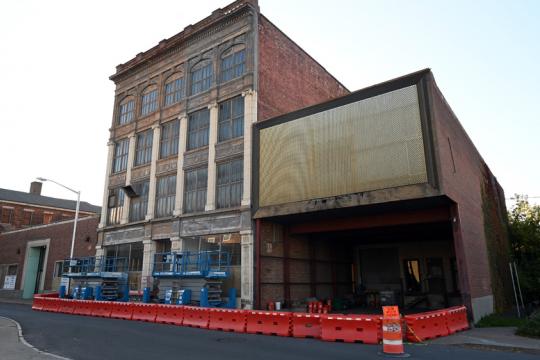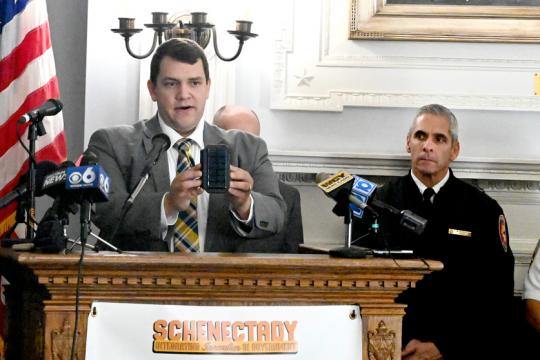City weighing gunshot-detection technology – The Daily Gazette
SCHENECTADY — The city will soon be joining Rochester and Syracuse in using gunshot-detection technology.
“It should be happening by the end of the year,” said city Police Chief Eric Clifford.
Clifford said the technology will be deployed in the neighborhoods that generate the majority of shots-fired calls, including Mont Pleasant, Hamilton Hill and Central State Street.
“We want to be able to use it where it’s needed the most,” he said.
The city is eyeing two different software programs that use acoustic sensors to detect gunshots and alert authorities to the location in real time.
“ShotSpotter will be in one zone, and we have acoustic sensors on the other side which will use different analytical technology, and we’ll compare the two,” said Mayor Gary McCarthy.
At least some of the sensors will be co-located on the new LED lights National Grid is installing as part of the city’s ongoing Smart Cities initiative.
The technology will be helpful with investigations, Clifford said, because many shootings go unreported until victims show up in hospital emergency rooms with gunshot wounds, or residents discover shell casings and alert authorities.
The sensors should also help improve response times, he said.
Over 100 localities nationwide use ShotSpotter, including New York City, Boston and Chicago.
DISCONTINUED IN TROY
In the Capital Region, Troy used the technology between 2009 and 2012 before discontinuing its usage, according to the Times Union, citing a lack of reliability, including the inability to differentiate between gunshots and traffic.
Clifford said he’s aware of Troy’s experience with the system, which cost $250,000 to install, but said the technology has changed “tremendously” in the past seven years.
Troy also ran into problems with notifications, he said.
“I think the notifications are going to be a lot faster,” Clifford said.
The total time from gunshot to alert is less than 60 seconds, according to ShotSpotter’s website.
Schenectady County District Attorney Robert Carney also acknowledged the issues in Troy, but also believes the technology has improved since then and carries the potential to be helpful.
“It depends on how quickly [law enforcement] can respond,” Carney said. “I would hope that the data would be transmitted to the [county] emergency operations center, which is the camera room, in the city.”
That operation doesn’t yet contain any Smart Cities cameras, he said.
“My hope is this network would be part of that operation so police could access it quickly,” Carney said.
Clifford said several operational details still need to be ironed out regarding who receives the preliminary reports and how the data is conveyed to officers.
“It could be something we want to deploy citywide at some point,” he said. “But we have to look at the cost involved.”
BUDGET TALKS CONTINUE
McCarthy was out of the office on Friday and said he didn’t have a specific cost breakdown for the units immediately at hand.
But funds will come out of the Smart Cities initiative.
This year, he’s asking the City Council for $2 million for the effort, and lawmakers are scheduled to take up the issue at a budget meeting on Monday.
Several have expressed concerns over transparency in how the funds are being allocated and the city’s long-term strategy.
City Council President Ed Kosiur praised the initiative, citing $5 million in previous investments.
But, he told attendees at a forum sponsored by the League of Women Voters at the Hon. Karen B. Johnson Schenectady County Public Library earlier this month: “I think we need more public comment and more public information on the program.”
Councilwoman Leesa Perazzo said she supports the cost-savings measures and security applications.
“The [City] Council has yet to receive a comprehensive plan for how the money is being spent,” she said.
Perazzo said she wants to see McCarthy present a plan outlining the initiative’s overall goals and costs and ultimately put the decision to voters through a referendum.
“I’m struggling with the $2 million in the capital budget proposed again when we don’t really have a solid plan to know how we’re moving forward,” Perazzo said.
Councilman Vince Riggi highlighted security concerns outlined in a recent Wall Street Journal report that cities are vulnerable to hackers breaking into municipal systems and holding data hostage through ransomware, including Baltimore and Atlanta.
“I may be a dinosaur, but technology changes just too fast for us to put a lot of money into this,” Riggi said. “I’d like to see a concrete plan from the administration before we move forward on this.”
Councilman John Polimeni said the city should do more to explore ways technology can be used to generate revenue — including using data to create marketing strategies for businesses in the city.
“We can also use this technology to create new businesses and applications that we can use to create employment opportunities,” Polimeni said.
In response to the criticisms, McCarthy said, “They haven’t had that same level of interest along the way.”














